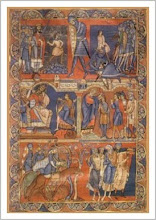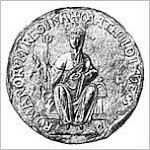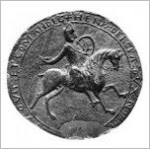• The Heptarchy - The Seven Kingdoms of Anglo-Saxon England
East Anglia: Ancient home of the East Angles
East Anglia was once the ancient Anglo-Saxon Kingdom of the East Angles, named after the homeland of the Angles, Angeln in northern Germany. It was formed approximately in 520AD by merging the North and the South Folk. They were Angles who had settled in the former lands of the Iceni during the previous century. The kingdom came to include the counties of Norfolk and Suffolk, Cambridgeshire, and parts of Lincolnshire. After the marriage of the East Anglian princess Etheldreda (Saint Etheldreda, often called Audrey), the third daughter of the Christian King Anna, the Isle of Ely also became part of the kingdom.
For a brief period East Anglia was the most powerful of the Anglo-Saxon kingdoms following a victory over the rival kingdom of Northumbria in the year 616AD, and King Raedwald was Bretwalda, overlord or high king of the Anglo-Saxon kingdoms 616-624AD. However, over the next forty years East Anglia was defeated by the Mercian’s twice.
In 794AD, Offa of Mercia had its king, Aethelberht, killed and took control of the kingdom himself, and the independence of the East Anglians wasn’t restored until a successful rebellion against Mercia in 825–827AD. Two Mercian kings were killed attempting to crush it.
On 20th November 870AD the Danes killed King Edmund and took the kingdom, which they named East Anglia. The Saxons retook the area in 920AD, only to lose it again in 1015–1017, when it was conquered by Canute the Great and given as a fiefdom to Thorkell the Tall, who was made Jarl of East Anglia in 1017.
Much of the area is characterised by its flatness, partly consisting of fenland, bog and reclaimed marshland, and some gently rolling hills. The land is fertile however, and farming and horticulture have been very successful. The main towns include Norwich, Ipswich, Ely, Peterborough, Huntingdon and Cambridge. Bury St Edmunds is named for East Anglian King Edmund.
Ipswich:
Under the Roman Empire, the area around Ipswich formed an important route inland to rural towns and settlements via the Orwell and Gipping. A large Roman fort, part of the coast defences of Britain, stood at Felixstowe and the largest villa in Suffolk stood at Castle Hill, in northwest Ipswich.
In Anglo-Saxon times Ipswich was the main centre between York and London for North Sea trade to Scandinavia and the Rhine. It served the Kingdom of East Anglia, and began developing in the time of King Raedwald. The famous ship burial and treasure at nearby Sutton Hoo could possibly be his grave.
The seventh century town which was called 'Gippeswick' was centred near the quay. Frisian potters from the Netherlands area settled in Ipswich in approximately 700AD and set up the first large scale potteries in England since Roman times. This industry was unique to Ipswich for 200 years and their wares were traded right across England. Ipswich grew prosperous and in about 720AD a new part of the town was laid out in the Buttermarket area. Parts of the ancient road plan still survive in its modern streets.
Ipswich operated a Mint under royal licence from King Edgar in the 970's, which continued through the Norman era until the time of King John about 1215. It was he who granted the town its first charter in 1200.
Sudbury:
Sudbury is a small, ancient market town in Suffolk on the River Stour, approximately 15 miles from Colchester and 60 miles from London. Sudbury’s earliest mention is in 799AD when Aelfhun, Bishop of Dunwich, died in the town. The town is also mentioned in the Domesday Book of 1086 as a market town.
The weaving and silk industries prospered for centuries during the Late Middle Ages and Sudbury prospered too. Many great houses and churches were built and The Woolsack in the House of Lords was originally stuffed with wool from the Sudbury area, a sign of both the importance of the wool industry and of the wealth of the donors.
Bury St Edmunds:
Bury St Edmunds is an ancient market town in Suffolk and one of the royal towns of the Saxons. In approximately 633AD Sigebert, King of the East Angles, founded a monastery here. The abbey became the burial place of King Edmund who was killed by the Danes in 869AD. It has also been stated that in 1214 the barons of England met in the Abbey Church and swore to force King John to accept the Charter of Liberties. This document influenced the creation of the Magna Carta. Parliaments were held in Bury St Edmunds in 1272, 1296 and 1446.
• The Fens:
The Fens
The Fens Waterways
• Archaeological Treasures of East Anglia:
Mildenhall Treasure:
The Mildenhall Treasure is a major hoard of 34 Roman silver objects found in the Mildenhall area of Suffolk.
Touring Britannia - The Mildenhall Treasure
The Mildenhall Treasure
The Great Dish
Mildenhall Treasure
Thetford Treasure:
The Thetford treasure artifacts include an engraved gem, a belt buckle and silver spoons.
The Thetford Treasure
Objects from the Thetford Treasure
Sutton Hoo:
The well known Sutton Hoo site contains a wealth of outstanding artifacts which are of great archaeological and historical significance, including an undisturbed ship burial. The site is located near Woodbridge, approximately 9 miles northeast of Ipswich, in Suffolk.
The Sutton Hoo Society
The National Trust - Sutton Hoo
• More about East Anglia:
• Find out more about East Anglia - Towns and Villages
• Check out the website East of England
• Explore a map of East Anglia at Pictures of England
• Resources - Books: Medieval East Anglia Edited by Christopher Harper-Bill
Subscribe to:
Post Comments (Atom)








No comments:
Post a Comment